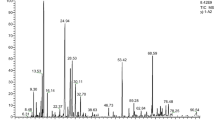Abstract
The antibacterial activities of vulgarone B, a component of Artemisia iwayomogi essential oil, were evaluated against some antibiotic-susceptible and -resistant human pathogens. Moreover, the effects of combining antibiotics, such as oxacillin, with vulgarone B were determined in this study. Significant inhibitory activities of Artemisia oils against antibiotic-susceptible and -resistant bacteria were confirmed by broth microdilution methods. The effects of vulgarone B on bacterial morphology and DNA were observed by scanning electron microscope and electrophoresis, respectively. In checkerboard microtiter tests, vulgarone B and A. iwayomogi oil combined with oxacillin resulted in synergism, or additive effects. Moreover, the safety of Artemisia oil and vulgarone B were confirmed in vivo. Both vulgarone B and the essential oil fraction of A. iwayomogi showed significant inhibitory activities against strains of antibioticsusceptible and -resistant bacteria. The oils showed synergism or additive effects when combined with oxacillin against two strains of Staphylococcus aureus. The antibiotic mechanism involved might be related to DNA cleavage. Thus, vulgarone B and the essential oil fraction of A. iwayomogi may be promising candidates for a safe, effective, natural agent active against antibiotic-resistant S. aureus, especially when combined with oxacillin.
Similar content being viewed by others
References
Acco, M., Ferreirab, F. S., Henriquesa, J. A. P., and Tondo, E. C., Identification of multiple strains of Staphylococcus aureus colonizing nasal mucosa of food handlers. Food Microbiol., 20, 489–493 (2003).
Andrysiak, A. K., Olson, A.B., Tracz, D. M., Dore, K., Irwin, R., Ng, L.-K., and Gilmour, M. W., Canadian Integrated program for antimicrobial resistance surveillance collaborative genetic characterization of clinical and agri-food isolates of multi drug resistant Salmonella enterica serovar Heidelberg from Canada. BMC Microbiol., 8, 89 (2008).
Berney, M., Hammes, F., Bosshard, F., Weilenmann, H., and Egli, T. Assessment and Interpretation of bacterial viability by using the LIVE/DEAD BacLight kit in combination with flow cytometry. Appl. Environ. Microbiol., 73, 3283–3290 (2007).
Burt, S., Essential oils: their antibacterial properties and potential applications in foods-a review. Int. J. Food Microbiol., 94, 223–253 (2004).
Cha, J. -D., Jeong, M. -R., Jeong, S. -I., Moon, S. -E., Kim, J. -Y., Kil, B. -S., and Song, Y. -H. Chemical composition and antimicrobial activity of the essential oils of Artemisia scoparia and A. iwayomogi. Planta Med., 71, 186–190 (2005).
Clinical and Laboratory Standards Institute Performance standards for antimicrobial susceptibility testing; seventh informational supplement 27, Suite, USA, pp. 98–114, (2007).
Davidson, P. M. and Parish, M. E., Methods for testing the efficacy of food antimicrobials. Food Technol., 43, 148–155 (1989).
Forbes, B. A., Bombicino, K., Plata, K., Cuirolo, A., Webber, D., Bender, C. L., and Rosato, A. E., Unusual form of oxacillin resistance in methicillin-resistant Staphylococcus aureus clinical strains. Diagn. Microbiol. Infect. Dis., 61, 387–395 (2008).
Guo, F. -Q., Liang, Y. -Z., Xu, C. -J., Li, X. -N., and Huang, L. -F., Analyzing of the volatile chemical constituents in Artemisia iwayomogi herba by GC-MS and correlative chemometric resolution methods. J. Pharm. Biomed. Anal., 35, 469–478 (2004).
Hald, T., Wong, L. F., Danilo, M. A,. and Aarestrup, F. M. The attribution of human infections with antimicrobial resistant Salmonella bacteria in Denmark to sources of animal origin. Foodborne Pathog. Dis., 4, 313–326 (2007).
Kuhn, H., Protozanova, E. and Demidov, V. V. Monitoring of single nicks in duplex DNA by gel electrophoretic mobilityshift assay. Electrophoresis, 23, 2384–2387 (2002).
Lambert, R. J. W., Skandamis, P. N., Coote, P. J., and Nychas, G. J. E., A study of the minimum inhibitory concentration and mode of action of oregano essential oil, thymol, and carvacrol. J. Appl. Microbiol., 91, 453–462 (2001).
La Salandra, G., Dambrosio, A., Quaglia, N. C., Parisi, A., Grecoa, G., Bellaciccoa, A. L., Virgilioc, S., and Celano, G. V., Methicillin-resistant Staphylococcus aureus (MRSA) in foods of animal origin product in Italy. Int. J. Food Microbiol., 117, 219–222 (2007).
Miyazawa, M. and Kameoka, H., The essential oil of Artemisia iwayomogi. Phytochemistry, 7, 1054–1057 (1977).
Schultz, T. H., Flath, R. A., Mon, T. R. Effling, S. B. and Teranishiu, R., Isolation of volatile components from a model system. J. Agr. Food Chem., 25, 446–449 (1977).
Shibata, H., Nakano, T., Parvez, M. A., Furukawa, Y., Tomoishi, A., Niimi, S., Arakaki, N., and Higuti, T., Triple combinations of lower and longer alkyl gallates and oxacillin improve antibiotic synergy against methicillinresistant Staphylococcus aureus. Antimicrob. Agents Chemother., 53, 2218–2220 (2009).
Shin, S. and Kim J. H., Antifungal activities of essential oils from Artemisia quinquecostatus and T. magnus. Planta Med., 70, 1087–1090 (2004).
Shin, S. and Lim, S., Antifungal effects of herbal essential oils alone and in combination with ketocoanzole against Trichophyton spp. J. Appl. Microbiol., 97, 1289–1296 (2004).
Sikkema, J., De Bont, J. A. M., and Poolman, B., Interactions of cyclic hydrocarbons with biological membranes. J. Biol. Chem., 269, 8022–8028 (1994).
Skinner, S., Murray, M., Walus, T., and Karlowsky, J. A., Failure of cloxacillin in treatment of a patient with border line oxacillin-resistant Staphylococcus aureus Endocarditis. J. Clin. Microbiol., 47, 859–861 (2009).
Ultee, A., Kets, E. P. W., and Smid, E. J., Mechanisms of action of carvacrol on the food-borne pathogen Bacillus cereus. Appl. Environ. Microbiol., 65, 4606–4610 (1999).
Varma, J. K., Marcus, R., Stenzel, S. A., Hanna, S. S., Gettner, S., Anderson, B. J., Hayes, T., Shiferaw, B., Grume, T. L., Joyce, K., Fullerton, K. E., Voetsch, A. C., and Angulo, F. J., Highly resistant Salmonella newport-MDRAmpC transmitted through the domestic US food supply: A food net case-control study of sporadic Salmonella newport infections, 2002–2003. J. Infect. Dis., 194, 222–230 (2006).
Author information
Authors and Affiliations
Corresponding author
Rights and permissions
About this article
Cite this article
Chung, E.Y., Byun, Y.H., Shin, E.J. et al. Antibacterial effects of vulgarone B from Artemisia iwayomogi alone and in combination with oxacillin. Arch. Pharm. Res. 32, 1711–1719 (2009). https://doi.org/10.1007/s12272-009-2208-8
Received:
Revised:
Accepted:
Published:
Issue Date:
DOI: https://doi.org/10.1007/s12272-009-2208-8




